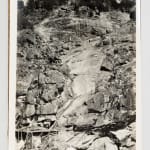[Southern California Edison Co.]
Construction of Dam No. 6 San Joaquin River, 1921-22
Photo album; silver prints (29)
Each 4 1/2 x 8 inches
With typed introduction and fold-out map.
With typed introduction and fold-out map.
Further images
-
(View a larger image of thumbnail 1
)

-
(View a larger image of thumbnail 2
)

-
(View a larger image of thumbnail 3
)

-
(View a larger image of thumbnail 4
)

-
(View a larger image of thumbnail 5
)

-
(View a larger image of thumbnail 6
)

-
(View a larger image of thumbnail 7
)

-
(View a larger image of thumbnail 8
)

Following the failure of a hydroelectric project for the San Joaquin Electric Company on the North Fork of the San Joaquin River, California engineer John S. Eastwood founded the Mammoth...
Following the failure of a hydroelectric project for the San Joaquin Electric Company on the North Fork of the San Joaquin River, California engineer John S. Eastwood founded the Mammoth Power Company. His initial plan, a rockfall dam on the San Joaquin, failed to attract adequate investment, but a subsequent plan, involving a stair step series of smaller reservoirs, managed to attract support.
In 1902, Henry E. Huntington, founder of the Pacific Light and Power Company (PL&P), hired Eastwood to build his dam. PL&P had been struggling to keep its capacity for generating electricity apace with the growth of Los Angeles. Eastwood’s plan was the perfect opportunity to gain a competitive advantage. Not that that helped him much; Huntington machinated to have Eastwood removed from the project and the company once plans were finished.
The first phase of construction began in 1912, resulting in two powerhouses and five dams. The economic boom of the post-WWI period presented an opportunity for expansion, and Southern California Edison (SCE), the company that absorbed PL&P in 1917, seized it. Dam no. 6 was constructed in record time to avoid floods. Excavation began in July of 1922, with all the concrete poured by January of the following year. For just one dam in the system, 40,254 cubic yards of soil was excavated, and 19,903 cubic yards of concrete was poured.
The full Big Creek Hydroelectric system as it exists today consists of 27 dams and 24 generating units, across 9 powerhouses. SCE continues to handle operation of the utility, which has a total capacity of more than 1,000 megawatts. The final expansion was completed in 1987. In 2016, the Big Creek Hydroelectric Project was listed on the National Register of Historic Places.
In 1902, Henry E. Huntington, founder of the Pacific Light and Power Company (PL&P), hired Eastwood to build his dam. PL&P had been struggling to keep its capacity for generating electricity apace with the growth of Los Angeles. Eastwood’s plan was the perfect opportunity to gain a competitive advantage. Not that that helped him much; Huntington machinated to have Eastwood removed from the project and the company once plans were finished.
The first phase of construction began in 1912, resulting in two powerhouses and five dams. The economic boom of the post-WWI period presented an opportunity for expansion, and Southern California Edison (SCE), the company that absorbed PL&P in 1917, seized it. Dam no. 6 was constructed in record time to avoid floods. Excavation began in July of 1922, with all the concrete poured by January of the following year. For just one dam in the system, 40,254 cubic yards of soil was excavated, and 19,903 cubic yards of concrete was poured.
The full Big Creek Hydroelectric system as it exists today consists of 27 dams and 24 generating units, across 9 powerhouses. SCE continues to handle operation of the utility, which has a total capacity of more than 1,000 megawatts. The final expansion was completed in 1987. In 2016, the Big Creek Hydroelectric Project was listed on the National Register of Historic Places.
![[Southern California Edison Co.], Construction of Dam No. 6 San Joaquin River, 1921-22](https://artlogic-res.cloudinary.com/w_1600,h_1600,c_limit,f_auto,fl_lossy,q_auto/artlogicstorage/dollc/images/view/ff7b13db92e57961c95694cf2c3b5206j/daniel-oliver-southern-california-edison-co.-construction-of-dam-no.-6-san-joaquin-river-1921-22.jpg)
![[Southern California Edison Co.], Construction of Dam No. 6 San Joaquin River, 1921-22](https://artlogic-res.cloudinary.com/w_1600,h_1600,c_limit,f_auto,fl_lossy,q_auto/artlogicstorage/dollc/images/view/d0b81ed67078ec5232e93ed7e068009cj/daniel-oliver-southern-california-edison-co.-construction-of-dam-no.-6-san-joaquin-river-1921-22.jpg)
![[Southern California Edison Co.], Construction of Dam No. 6 San Joaquin River, 1921-22](https://artlogic-res.cloudinary.com/w_1600,h_1600,c_limit,f_auto,fl_lossy,q_auto/artlogicstorage/dollc/images/view/eb86d7b6a606841434fc3c25f9ae8172j/daniel-oliver-southern-california-edison-co.-construction-of-dam-no.-6-san-joaquin-river-1921-22.jpg)
![[Southern California Edison Co.], Construction of Dam No. 6 San Joaquin River, 1921-22](https://artlogic-res.cloudinary.com/w_1600,h_1600,c_limit,f_auto,fl_lossy,q_auto/artlogicstorage/dollc/images/view/725dc6cb0eda819fb9002286c157b6a8j/daniel-oliver-southern-california-edison-co.-construction-of-dam-no.-6-san-joaquin-river-1921-22.jpg)
![[Southern California Edison Co.], Construction of Dam No. 6 San Joaquin River, 1921-22](https://artlogic-res.cloudinary.com/w_1600,h_1600,c_limit,f_auto,fl_lossy,q_auto/artlogicstorage/dollc/images/view/2ae7f02c6dc3210e012784828ffa6a7cj/daniel-oliver-southern-california-edison-co.-construction-of-dam-no.-6-san-joaquin-river-1921-22.jpg)
![[Southern California Edison Co.], Construction of Dam No. 6 San Joaquin River, 1921-22](https://artlogic-res.cloudinary.com/w_1600,h_1600,c_limit,f_auto,fl_lossy,q_auto/artlogicstorage/dollc/images/view/3fa8d9e6a921e92d375e731899350450j/daniel-oliver-southern-california-edison-co.-construction-of-dam-no.-6-san-joaquin-river-1921-22.jpg)
![[Southern California Edison Co.], Construction of Dam No. 6 San Joaquin River, 1921-22](https://artlogic-res.cloudinary.com/w_1600,h_1600,c_limit,f_auto,fl_lossy,q_auto/artlogicstorage/dollc/images/view/70fc658f234c3477035c3ee3df438818j/daniel-oliver-southern-california-edison-co.-construction-of-dam-no.-6-san-joaquin-river-1921-22.jpg)
![[Southern California Edison Co.], Construction of Dam No. 6 San Joaquin River, 1921-22](https://artlogic-res.cloudinary.com/w_1600,h_1600,c_limit,f_auto,fl_lossy,q_auto/artlogicstorage/dollc/images/view/458be567ef3723aeae2f466a43ec4119j/daniel-oliver-southern-california-edison-co.-construction-of-dam-no.-6-san-joaquin-river-1921-22.jpg)